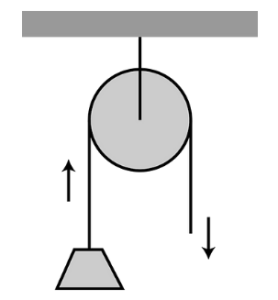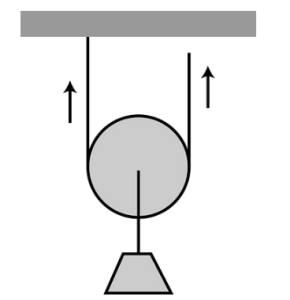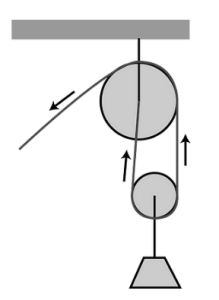A pulley is a wheel with a flexible rope, cord, cable, chain, or belt attached to the rim. Pulleys are used to transport energy and motion, either alone or in combination. Sheaves are rimmed pulleys with grooves.
Pulley
We come across several machines in our daily lives that we sometimes fail to notice them. One of them is Pulley. A pulley is essentially a rope wrapped around a wheel’s groove. Pulleys can be used to transport energy and motion alone or in combination. The equipment used to raise a flag is a simple example of a pulley. A pulley can be used to lift weights. Pulleys make our jobs easier, and we can employ them to our advantage if we understand how they function. The pulley, its mechanical benefits, types, and how to solve a pulley problem will all be discussed here.
A pulley is a mechanical device that lifts objects and consists of a wheel and a rope. Pulleys come in a variety of sizes. There are a variety of pulley sizes commercially available. A pulley freely revolves along an axis that runs through its centre.
We can simply raise big objects with the help of a pulley. The most basic and greatest example of a pulley can be found in most village wells, in which a bucket is attached to one end of the pulley that goes down into the well and the upper section of the rope is pulled by hand.
The Physics of Pulleys
The movement of the pulley system is supported by wheels on axles or shafts. It not only transfers power between the shaft and the belt, but it also alters the belt’s direction.
When a support frame or shell is attached to the pulley system, power is not transferred to the shaft. Cables are directed and force is exerted in specific directions using it. The shell is essentially a block in the pulley system. This is referred to as a sheave.
Mechanism of Pulley System
Pulleys are one of the most important instruments in the trade since they allow you to raise huge objects with little effort. It has become one of the most significant instruments because it is a one-of-a-kind mechanism. It is employed in a variety of machines in the industry.
Even though the pulley system makes it simple to raise huge objects, the mechanics of the pulley system can get complicated at times.
Types of Pulley
The three most prevalent and prominent categories of pulleys in today’s world are as follows:
- Fixed Pulley
- Movable Pulley
- Compound Pulley
Fixed Pulley
Fixed Pulleys are not movable since they are attached to a rigid structure. These pulleys are commonly found in ceilings, walls, and floors. As an outcome, the system is at rest. The rope, on the other hand, is free to move. In this arrangement, there is only one section pulling up. There is a shift in the direction of a force, and the ideal mechanical advantage is one.
This system allows to change the direction of the implemented force. It also eliminates the need for someone to carry a hefty object off the ground. The ones mounted atop a deep well are some of the examples.

Movable Pulley
A movable pulley is not attached to a fixed structure. One of the rope’s ends is attached to a sturdy structure. Instead of ropes, wheels carry the load in this device. The burden transfers from one position to another when one end of the rope is tugged. This type of pulley necessitates a small bit of effort.

Compound Pulley
It combines the capabilities of both fixed and movable pulleys. The rope tied to a fixed pulley links with the movable pulley in this arrangement. As a result, one can adjust the position of the movable wheel by increasing the weight on it. It allows one to divert force while also changing the overall workload of that force based on one’s needs.

Pulleys with Compound Shafts
A fixed pulley and a movable pulley are combined to create a compound pulley. The mechanism was created to make it easier to carry by decreasing the amount of effort required to less than half the load’s weight. When cranes are used to raise massive steel or concrete objects at building sites, pulley systems are commonly used.
Pulleys for Blocking and Tackling
Two or more pulleys are connected with a rope or cable to raise large loads that are used to move blocks, in block and tackle systems. The block system that connects the pulleys is made out of assembled pulleys. Then a pair of blocks are positioned so that one pulley is always stationary and the other is always moving.
Advantages of Pulley
The most important and well-known benefit of the pulley is that it requires less effort to lift a weight as compared to normal lifting.
It primarily decreases the amount of force needed to lift large objects.
The real direction of force varies while employing a pulley.
A mechanical advantage is gained by changing the direction of force and reducing the quantity of force.
In addition, there is a benefit in terms of the distance between the operator and the weight. The task of an operator can be done from afar.
While raising the weight, a safe distance shall be maintained to avoid any mishaps.
Another benefit of the pulley system is that it is simple to put together and inexpensive.
Disadvantages of Pulley
After looking over all of the benefits of the pulley system, it is important to note that it also has some drawbacks. The first disadvantage is that installing and using a pulley requires a lot of room.
For mechanical advantage, we may also employ a big number of pulleys, but this will require a lot of room.
When employing ropes or belts over wheels without grooves, there is a risk of slipping.
As friction creates wear and tear between the rope and the wheel, if the pulleys are used for a long time, some maintenance and regular inspection of the cables/ropes/belts is required.
Ropes that are used often become brittle. The rope can sometimes break while being employed by the operator, producing problems.
Conclusion
A pulley is a mechanical device that lifts objects and consists of a wheel and a rope. Pulleys come in a variety of sizes. There are a variety of pulley sizes commercially available. A pulley freely revolves along an axis that runs through its centre. The movement of the pulley system is supported by wheels on axles or shafts. It not only transfers power between the shaft and the belt, but it also alters the belt’s direction.
 Profile
Profile Settings
Settings Refer your friends
Refer your friends Sign out
Sign out




